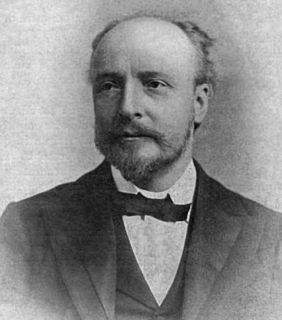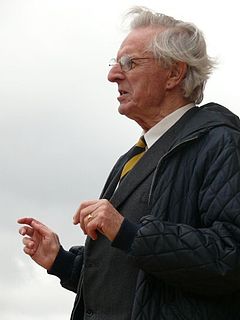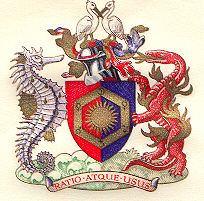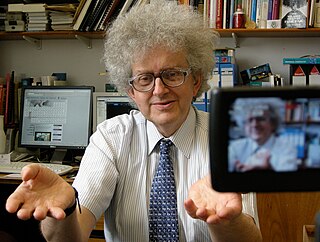
Sir James Dewar FRS FRSE was a Scottish chemist and physicist. He is best known for his invention of the vacuum flask, which he used in conjunction with research into the liquefaction of gases. He also studied atomic and molecular spectroscopy, working in these fields for more than 25 years.

The Cavendish Laboratory is the Department of Physics at the University of Cambridge, and is part of the School of Physical Sciences. The laboratory was opened in 1874 on the New Museums Site as a laboratory for experimental physics and is named after the British chemist and physicist Henry Cavendish. The laboratory has had a huge influence on research in the disciplines of physics and biology.

Sir William Lawrence Bragg, was an Australian-born British physicist and X-ray crystallographer, discoverer (1912) of Bragg's law of X-ray diffraction, which is basic for the determination of crystal structure. He was joint winner of the Nobel Prize in Physics in 1915: "For their services in the analysis of crystal structure by means of X-ray", an important step in the development of X-ray crystallography.

The Royal Institution of Great Britain is an organisation devoted to scientific education and research, based in London. It was founded in 1799 by the leading British scientists of the age, including Henry Cavendish and its first president, George Finch, the 9th Earl of Winchilsea. Its foundational principles were diffusing the knowledge of, and facilitating the general introduction of, useful mechanical inventions and improvements, as well as enhancing the application of science to the common purposes of life.

Sir William Henry Bragg was a British physicist, chemist, mathematician, and active sportsman who uniquely shared a Nobel Prize with his son Lawrence Bragg – the 1915 Nobel Prize in Physics: "for their services in the analysis of crystal structure by means of X-rays". The mineral Braggite is named after him and his son. He was knighted in 1920.
Sira is a UK-based notified body, specialising in ATEX, IECEX and North American product approvals.

Sir Arnold Whittaker Wolfendale FRS is a British astronomer who served as Astronomer Royal from 1991 to 1995. He is Emeritus Professor in the Department of Physics at Durham University and served as president of the European Physical Society (1999–2001).

Edward Neville da Costa Andrade FRS was an English physicist, writer, and poet. He told The Literary Digest his name was pronounced "as written, i.e., like air raid, with and substituted for air." In the scientific world Andrade is best known for work that first determined the wavelength of a type of gamma radiation, proving it was far higher in energies than X-rays known at the time. In popular culture he was best known for his appearances on The Brains Trust.

The Royal Institute of Chemistry was a British scientific organisation.

Sir David Orme Masson KBE FRS FRSE LLD was a scientist born in England who emigrated to Australia to become Professor of Chemistry at the University of Melbourne. He is known for his work on the explosive compound Nitroglycerine.
Sir Peter Knight, FRS is a British physicist, professor of quantum optics and senior research investigator Imperial College London, and principal of the Kavli Royal Society International Centre.

Professor Sir Martyn Poliakoff is a British chemist, working on gaining insights into fundamental chemistry, and on developing environmentally acceptable processes and materials. The core themes of his work are supercritical fluids, infrared spectroscopy and lasers. He is a research professor in chemistry at the University of Nottingham. His group comprises several members of staff, postdoctoral research fellows, postgraduate students and overseas visitors. As well as carrying out research at the University of Nottingham, he is a lecturer, teaching a number of modules including green chemistry. He is also known for his leading role in The Periodic Table of Videos.

Ei-ichi Negishi is a Manchurian-born Japanese chemist who has spent most of his career at Purdue University in the United States. He is the Herbert C. Brown Distinguished Professor and Director of the Negishi-Brown Institute at Purdue. He is best known for his discovery of the Negishi coupling. He was awarded the 2010 Nobel Prize in Chemistry "for palladium catalyzed cross couplings in organic synthesis" jointly with Richard F. Heck and Akira Suzuki.
Sir William Jackson Pope was an English chemist.
Sir Ewart Ray Herbert Jones FRS was a Welsh organic chemist and academic administrator, whose fields of expertise led him to discoveries into the chemistry of natural products, mainly steroids, terpenes and vitamins. His work also led to the creation of the Jones oxidation.
Neil Kensington Adam was a British chemist.
Sir Arthur Herbert Church was a British chemist, expert on pottery, stones and chemistry of paintings, who discovered turacin in 1869 and several minerals, including the only British cerium mineral.
Sir Robert Howson Pickard FRS was a chemist who did pioneering work in stereochemistry and also for the cotton industry in Lancashire. He was also involved in educational administration and was Vice Chancellor of the University of London from 1937-1939. He was Principal of Battersea Polytechnic from 1920 to 1927.
Prof Frederic Guy Marrian FRS FRSE FIC CBE (1904-1981) was a British biochemist mainly known for his research into oestregen.
Prof John Read FRS FRSE FCS FIC (1884–1963) was a British chemist and scientific author.













